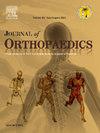全膝关节置换术与单髁膝关节置换术在术后恢复强化方案中的疗效对比
IF 1.5
Q3 ORTHOPEDICS
引用次数: 0
摘要
导言膝关节非隔间置换术(UKA)因恢复更快、活动范围更大而广受欢迎。然而,有人担心早期失败的风险会增加。本研究旨在比较接受全膝关节置换术(TKR)和 ERAS 方案下的 UKA 患者 6 个月的功能预后。方法分析患者特征和合并症、术后 30 天再入院率和感染率。术前和术后6个月对患者报告的结果进行评估,即膝关节社会功能和膝关节评分(KSFS、KSKS)、牛津膝关节评分(OKS)以及短表健康调查(SF-36)的身体和精神部分。结果单变量分析显示,UKA 患者术前和术后 6 个月的 KSKS 和 SF-36 MCS 均明显好转。多变量分析显示,UKA 和 TKR 患者术后 6 个月的功能结果评分没有差异。没有UKA患者需要进行翻修手术,而4名TKR患者因感染需要进行翻修手术。UKA是单关节膝关节骨性关节炎患者的合理选择。本文章由计算机程序翻译,如有差异,请以英文原文为准。
Outcomes of total knee replacement versus unicompartmental knee arthroplasty in an enhanced recovery after surgery protocol
Introduction
Unicompartmental Knee Arthroplasty (UKA) has become popular due to faster recovery and improved range of motion. However, concerns have been made regarding increased risk of early failure. Furthermore, the use of Enhanced Recovery After Surgery (ERAS) protocols have shown to allow faster return to activities, improved satisfaction, and reduced complication rates.
This study aims to compare the 6 month functional outcomes of patients undergoing Total Knee Replacement (TKR) versus UKA under the ERAS protocol.
Methods
Patient characteristics and comorbidities, 30-day post-operation readmission and infection rates were analyzed. Patient reported outcomes measures namely the Knee Society Function and Knee Score (KSFS, KSKS), Oxford Knee Score (OKS) and both the Physical and Mental component of the Short-Form Health Survey (SF-36) were assessed pre-operatively and 6 months post-operatively.
Univariate analysis was used to compare differences in characteristics and comorbidities between the 2 groups. Finally, a multiple linear regression was performed to compare the post-operative outcomes.
Results
Univariate analysis showed significantly better preoperative and 6 month post-operative KSKS and SF-36 MCS in UKA patients. Multivariate analysis showed no difference in the 6 month post-operative functional outcome scores between UKA and TKR patients. No UKA patients required revision surgery while 4 TKR patients required revision surgery for infection.
Conclusion
UKA achieves equivalent functional outcomes at 6 months post-operatively as compared to TKR patients and has lower infection rates. UKA is a reasonable option to offer for unicompartmental knee osteoarthritis patients.
求助全文
通过发布文献求助,成功后即可免费获取论文全文。
去求助
来源期刊

Journal of orthopaedics
ORTHOPEDICS-
CiteScore
3.50
自引率
6.70%
发文量
202
审稿时长
56 days
期刊介绍:
Journal of Orthopaedics aims to be a leading journal in orthopaedics and contribute towards the improvement of quality of orthopedic health care. The journal publishes original research work and review articles related to different aspects of orthopaedics including Arthroplasty, Arthroscopy, Sports Medicine, Trauma, Spine and Spinal deformities, Pediatric orthopaedics, limb reconstruction procedures, hand surgery, and orthopaedic oncology. It also publishes articles on continuing education, health-related information, case reports and letters to the editor. It is requested to note that the journal has an international readership and all submissions should be aimed at specifying something about the setting in which the work was conducted. Authors must also provide any specific reasons for the research and also provide an elaborate description of the results.
 求助内容:
求助内容: 应助结果提醒方式:
应助结果提醒方式:


